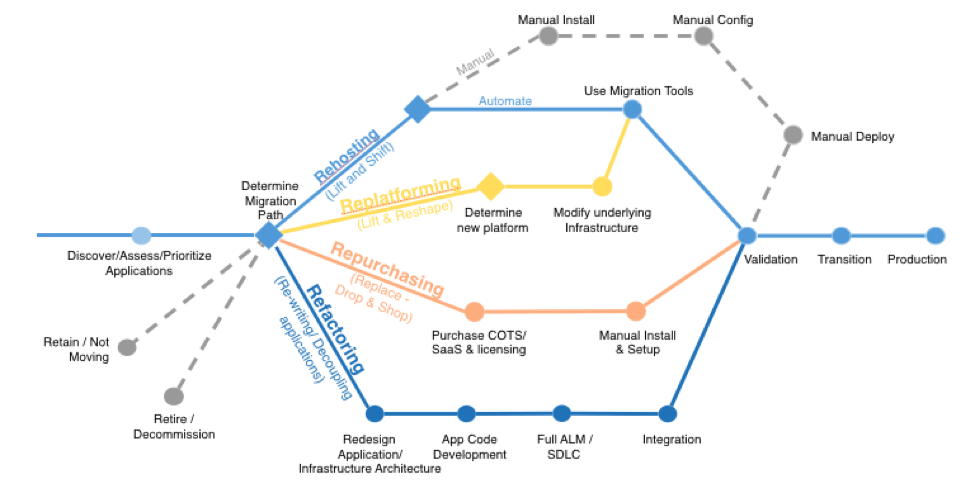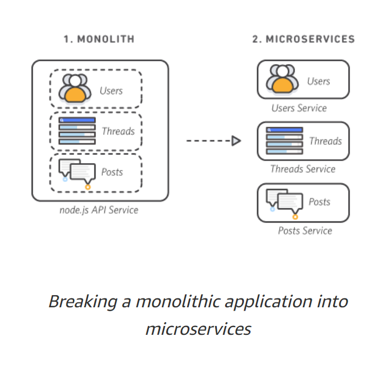By Chris Saso, Chief Technology Officer
Starting in early 2016, Dasher began to see many of our clients embrace public cloud as one of their platforms to run production workloads on. Through experience consulting our clients, we have seen plans that worked well, and some plans that did not. However, there is one universal truth for cloud migration: Leveraging cloud services “is a journey and not a destination.”
Let’s explore some of the strategies that a company should consider as they embark on their journey to the cloud:
Formulate a List of Your “Basic Needs”
Executive Sponsorship
Migrating to the cloud requires an investment in people and financial resources. It is expected that members of your cloud team will continue to support existing company applications and procedures while they develop new methods and start supporting applications running in the cloud. Securing executive buy-in and executive sponsorship is vital to establishing a corporate cloud strategy that can be shared with the rest of the organization. The cloud journey will require the reallocation of staff resources from other groups within an organization, which does not happen without executive support.
Create a Migration to the Cloud Cross-functional Team
Migrating to the cloud is an iterative process. Companies are unique, so there is no one-size-fits-all approach. Each company must build its own strategy and implementation of cloud services. Keep in mind that your company will get its “cloud strategy” wrong the first time, so be prepared to adapt quickly.
Dasher recommends that our clients assemble agile cross-functional teams that can quickly spot issues and be ready to effectively address them. Leveraging cloud services requires input from many disciplines within an organization. These teams include representatives from:
- Architecture
- Development
- IT/Operations
- Financial
- Legal
- Security
- Executive
First Migration Project (Proof of Concept)
One of the more traditional myths in moving to the cloud is that an in-depth analysis has to be performed against all the applications and infrastructure running in the on-premise data center to determine their public cloud dependencies, performance requirements, security requirements, architecture requirements, legal requirements, and so on. Unfortunately, performing this kind of in-depth analysis requires a significant amount of time, human, and financial capital.
In the world of rapidly changing organizations, by the time an in-depth data center assessment is complete, the applications and underlying infrastructure are most likely going to have changed. Our engineering team is known for saying, “Networking documentation tends to be outdated as soon as it is written, so make sure you are prepared for operationalizing management of your solutions.”
There is value in performing assessments. A preferred strategy is to:
- Perform a high level assessment of the data center to identify key critical applications and their supporting infrastructure components.
- Identify one or two candidate applications for migration to the cloud. Pick one application for a cloud migration proof of concept (POC).
- Work with the cross-functional team to perform an in-depth assessment of the candidate application and its cloud requirements.
- Build a cloud landing zone. This needs to be the minimum-viable environment required to run the POC application.
- Migrate the POC application into the minimum-viable cloud landing zone.
- The cloud migration cross functional team should review the POC application and cloud landing zone to identify requirements that meet your business objectives.
- Make changes to the POC application and the cloud landing zone.
- Repeat steps six and seven until all the business requirements have been met.
By using this strategy, the company can run a low-risk study on how best to develop an organic cloud migration strategy. Also, after the completion of this process, the company learns how to identify which of their applications will quickly move and which will have to remain in their on-prem data center. By using this strategy, the organization can develop procedures for the migration of the rest of the applications in the data center. If you are not clear where to start, Dasher is here to help you identify the candidate application, create and manage the POC process with you.
Migration
How Do I Migrate?
In 2011, Gartner produced a report on different strategies that can be used to perform cloud migrations. Over the years, this has been tweaked by various public cloud providers, but the list below is the generally accepted six options for migrating to the cloud.
- Repurchase an application in an SaaS platform. Examples of this strategy are moving from on-premise Microsoft Exchange to Office 365. Dasher migrated to O365 in 2013, when we moved offices to a new building. This was an easy decision for Dasher because it simplified our use and management of one of our key company applications. We saved budget on new hardware that would have been required to stand up a new Exchange environment. Now we have helped many clients migrate from on-premise Exchange to O365.
- Rehost on the public cloud. This is a migration strategy in which you “lift and shift” the application to the public cloud without making any significant architectural or application changes to it. This is the path of least resistance and the method most companies utilize when migrating their first application to the cloud.
- Replatform the application/core infrastructure to a different “home” in the public cloud. Some examples of this strategy involve moving from HPE HP/UX to RedHat Linux or swapping out an on-premise firewall for a firewall cloud service. For example, moving from an on-prem physical Palo Alto Networks firewall to a cloud-based GlobalProtect Cloud Service. Comparing the two options is something we do for our clients on a regular basis.
- Re-architect the application or architecture. In this strategy, you re-architect the infrastructure, e.g. use PaaS databases versus running your MySQL databases or rewriting the application code. For example, to make use of Kubernetes containers. During this phase, some organizations choose to adopt new software release methodologies such as continuous integration.
- Retain in your on-premise data center. This is where you do not move your application to the public cloud, but instead make the decision to keep it on-prem. This strategy is suitable for workloads that have a well-understood performance and capacity characteristics. Critical architecture decisions need to be made especially when there are application dependencies with services that live in public cloud.
- Retire applications and infrastructure. The decision is made to create a completely new application in the cloud and retire an existing application and the hardware it runs on.

Source: Amazon Web Services: 6 Strategies for Migrating Applications to the Cloud
Biting Off More Than You Can Chew?
When it comes to actual migration, there are two strategies that we recommend.
Method One: Lift and Shift
The first method involves picking up entire applications and moving them to the cloud. One example of this is using lift and shift to move 60 servers that make up various parts of the presentation, application and database layers to the cloud. There are advantages and disadvantages to this strategy.
Pros
- Once the migration is complete, the entire application lives in the cloud and can be served from the cloud.
- Applications that are designed correctly from the start may not need to be redesigned.
Cons
- There are longer migration times because of the size of the data that must be moved and could be very large.
- There is more application downtime and longer cutover times because you need to account for the cutover times in all the facets of the application.
- This type of migration requires more planning and coordination between the various teams that manage different parts of the application (database teams, application teams, etc.).
- There is also a higher risk of failure because it is an all or nothing migration. In the case of a migration failure, rollbacks can take a long time.
Method Two: Creating Microservices

Source: Amazon Web Services: What are Microservices?
The second method involves breaking up the application into smaller functional components and tackling each component as a single unit. For example, with the same three-tier application, start with just moving it to a content delivery network. Next, move the web servers, then the application servers, then the database servers. There are also advantages and disadvantages to this strategy.
Pros
- This method is very fast, since you are migrating a small portion of the application, then iterating to the next. Shorter downtimes and cutover are required.
- There are smaller teams that require to manage the migration with minimized coordination with each supporting unit. Each functional unit can also take ownership of their portion of the move and use the method that best suits their workflow.
- There is a lower risk of failure, since only one functional section of the application is being migrated in each phase. In the case of a migration failure, there is a shorter rollback time.
Cons
- Application infrastructure architecture might suffer during the migration because the application must straddle both the on-premise datacenter and the public cloud.
- There is the heavy reliance on the company’s network to handle the data that must move between public and private cloud. A robust and performant WAN is a must. Technologies such as SD-WAN might be employed to ease the potential performance hits that could occur during such a migration.
- As earlier stated in this article, each company’s journey to the cloud is unique, so one has to look at various factors to determine which path best suits them, that being said, taking small bites of the cloud tend to be easier to swallow than large bites.
Securing Your Cloud
Security is critical. Applications in the public cloud are not secure just because they are in the cloud. Securing your data and applications in the cloud requires planning and expertise. Security should involve ongoing monitoring and remediation that is no less stringent than what is employed in your corporate network. There are a vast array of companies new and well established that we work with to ensure our clients are securely using and deploying cloud resources. New technologies and topics like Virtual Firewall, CASB, SD-WAN, Software Defined Perimeter (SPD), Zero Trust Computing are all areas of security that Dasher has been becoming expert at as we continue our own journey to the cloud, ensuring we can offer our clients cloud solutions with security planned in from the start.
Just Migrate It
Once the organization has defined its strategy, the next step involves getting the work done. Time to jump behind the keyboard, architect and move applications. During this period, there is a great deal of resource contention, with the first significant contention being human capital. The technical staff must support the existing applications and at the same time support the migration of applications to the cloud. Here are some ways we are seeing that the industry is using to cope with the resource challenges during migration:
- Companies find that staff augmentation elevates the burden on their full-time staff and reduces the time for the migration to take place. It also allows an expert in the cloud to be brought in to help ramp up the expertise of your in-house staff.
- Application partners and tools such as Cloud Endure help ease the migration.
- Project based professional services can be employed to perform the migration.
There is also infrastructure resource contention. The physical network must support the bandwidth of migrating the application to the cloud and at the same time, serve the application to paying customers. When using application migration agents, potential contention to memory and CPU resources could occur.
Final Thoughts on the Journey
Once the initial migration is complete, we find that most organizations discover that they gain many benefits almost immediately. The first significant benefit is business agility – the ability to try out new things quickly. Because the public cloud provider manages the data center for you, fewer people are required to manage cloud infrastructure as compared to physical infrastructure. Companies can then focus on their core intellectual property. This leads to greater workforce productivity. There is also increased operational resilience. An organization can quickly recover from an event caused by resource contention by scaling out to more resources faster in the cloud.

Migration to the cloud is like a journey to the top of Mt. Everest. It should be planned for, managed, experts should be engaged, make a stop at base camp and get acclimated before you make your final ascent and then finally, go all in. Once you reach the top (after a lot of hard work), your view of the world changes and you feel an incredible sense of accomplishment because you have achieved something that not every person does well.
Keep these tenants in mind as you plan for your journey to the cloud.
- High Availability: Applications in the public cloud are expected to be cloud-native which means they need to have built-in resiliency and be able to make use of multiple regions and availability zones.
- Cost Optimization: Leveraging features such as auto-scaling, content delivery networks, object storage, functions as a service, and managed databases allow users to run servers only when they are absolutely needed.
- Security from the start: Do not rely on the public cloud providers to provide security solutions that are robust enough to manage your cloud workloads and data. Plan security into your future cloud architecture. Dasher leverages the CIS Top 20 to help our Clients being a secure cloud journey.
- Robust Network: Because applications based on compute and storage and networking can be migrated to the cloud and the humans can’t be, a robust LAN and WAN is critical to leveraging cloud applications.
- Research DevOps: With migration to the cloud, companies have the agility to try new things with little capital risk. This new agility requires new ways of software development and operations. Send your teams to DevOps training like Dasher has done and get up to speed on the next wave of development and operational practices. It is time to learn about containers!
If you made it to the end of the blog, thank you! You have begun your cloud journey or have continued your journey. Dasher has been helping clients design IT solutions since 1998 and we look forward to helping you on your journey to the cloud now and in the future.

